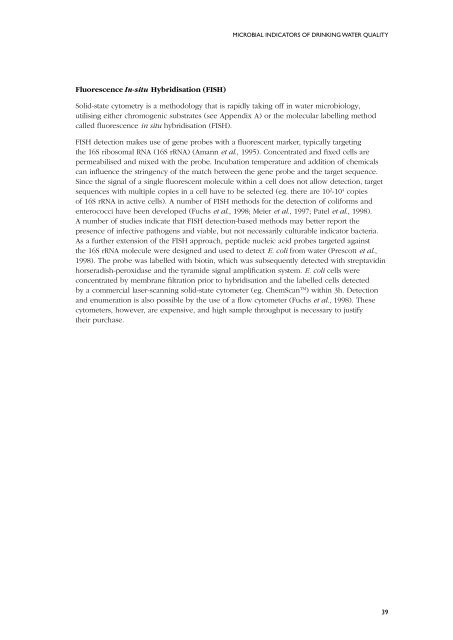Review of Coliforms - National Health and Medical Research Council
Review of Coliforms - National Health and Medical Research Council
Review of Coliforms - National Health and Medical Research Council
Create successful ePaper yourself
Turn your PDF publications into a flip-book with our unique Google optimized e-Paper software.
Fluorescence In-situ Hybridisation (FISH)<br />
MICROBIAL INDICATORS OF DRINKING WATER QUALITY<br />
Solid-state cytometry is a methodology that is rapidly taking <strong>of</strong>f in water microbiology,<br />
utilising either chromogenic substrates (see Appendix A) or the molecular labelling method<br />
called fluorescence in situ hybridisation (FISH).<br />
FISH detection makes use <strong>of</strong> gene probes with a fluorescent marker, typically targeting<br />
the 16S ribosomal RNA (16S rRNA) (Amann et al., 1995). Concentrated <strong>and</strong> fixed cells are<br />
permeabilised <strong>and</strong> mixed with the probe. Incubation temperature <strong>and</strong> addition <strong>of</strong> chemicals<br />
can influence the stringency <strong>of</strong> the match between the gene probe <strong>and</strong> the target sequence.<br />
Since the signal <strong>of</strong> a single fluorescent molecule within a cell does not allow detection, target<br />
sequences with multiple copies in a cell have to be selected (eg. there are 10 2 -10 4 copies<br />
<strong>of</strong> 16S rRNA in active cells). A number <strong>of</strong> FISH methods for the detection <strong>of</strong> coliforms <strong>and</strong><br />
enterococci have been developed (Fuchs et al., 1998; Meier et al., 1997; Patel et al., 1998).<br />
A number <strong>of</strong> studies indicate that FISH detection-based methods may better report the<br />
presence <strong>of</strong> infective pathogens <strong>and</strong> viable, but not necessarily culturable indicator bacteria.<br />
As a further extension <strong>of</strong> the FISH approach, peptide nucleic acid probes targeted against<br />
the 16S rRNA molecule were designed <strong>and</strong> used to detect E. coli from water (Prescott et al.,<br />
1998). The probe was labelled with biotin, which was subsequently detected with streptavidin<br />
horseradish-peroxidase <strong>and</strong> the tyramide signal amplification system. E. coli cells were<br />
concentrated by membrane filtration prior to hybridisation <strong>and</strong> the labelled cells detected<br />
by a commercial laser-scanning solid-state cytometer (eg. ChemScan TM ) within 3h. Detection<br />
<strong>and</strong> enumeration is also possible by the use <strong>of</strong> a flow cytometer (Fuchs et al., 1998). These<br />
cytometers, however, are expensive, <strong>and</strong> high sample throughput is necessary to justify<br />
their purchase.<br />
39

















